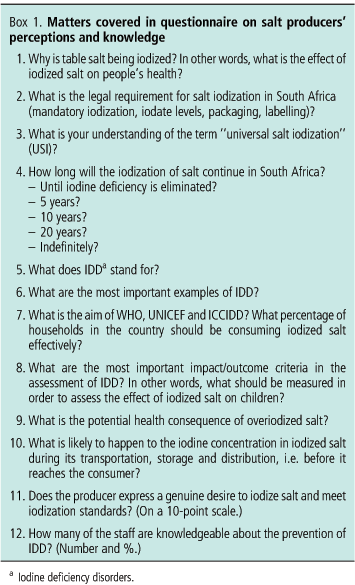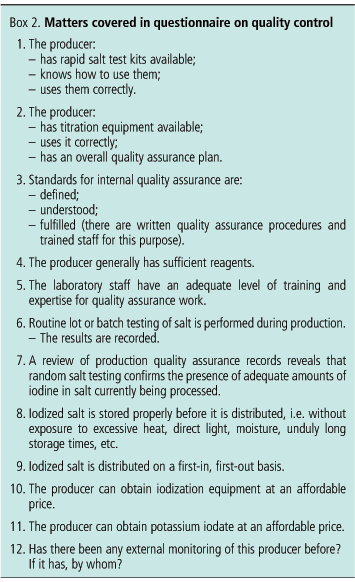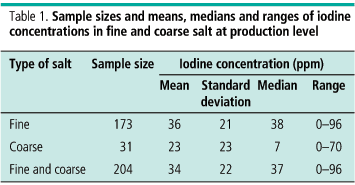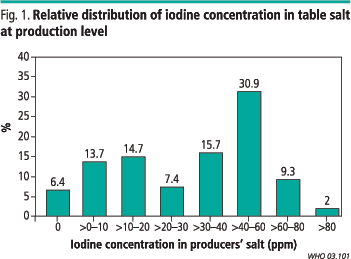RESEARCH
Assessment of the iodine concentration in table salt at the production stage in South Africa
Evaluation, à la production, de la teneur en iode du sel de table en Afrique du Sud
Evaluación de la concentración de yodo en la sal de mesa en la fase de producción en Sudáfrica
Pieter L. Jooste
Chief Specialist Scientist, Nutritional Intervention Research Unit, Medical Research Council, PO Box 19070, Tygerberg 7505, Cape Town, South Africa (email: pieter.jooste@mrc.ac.za)
ABSTRACT
OBJECTIVE: To determine the iodine content of iodized salt at the production stage, to assess the perceptions and knowledge of salt producers about the prevention and control of iodine deficiency, and to examine the internal quality control procedures used during iodization in South Africa.
METHOD: Salt samples were collected for iodine analysis by titration from the 12 producers iodizing salt in South Africa. Information on the producers' knowledge of iodine deficiency disorders and on internal quality control was obtained by means of questionnaires.
FINDINGS: The legal requirement of 4060 ppm iodine was met in 30.9% of salt samples; 57.9% contained more than 30 ppm iodine; 34.8% contained under 20 ppm iodine. There were shortcomings in perceptions and knowledge about iodine deficiency disorders and in the internal quality control procedures of a substantial proportion of the producers.
CONCLUSION: In order to encourage and support salt producers to achieve optimal iodization there should be an information, education and communication strategy aimed at improving knowledge of iodine deficiency disorders and at raising the standard of internal quality control procedures. External monitoring should continue.
Keywords: Sodium chloride, Dietary/analysis/therapeutic use; Iodine/deficiency; Deficiency diseases/prevention and control; Chemical industry/standards; Knowledge, attitudes, practice; Quality control; South Africa (source: MeSH, NLM).
RÉSUMÉ
OBJECTIF: Déterminer la teneur en iode lors de la production du sel soumis à une iodation pour évaluer les perceptions et les connaissances des producteurs de sel concernant la prévention de la carence en iode et la lutte contre ce déficit, et examiner les procédés de contrôle interne de la qualité utilisés pendant l'iodation.
MÉTHODES: Des échantillons de sel provenant de 12 producteurs qui procèdent à l'iodation du sel en Afrique du Sud ont été recueillis en vue du titrage de l'iode. Les données sur les connaissances des producteurs au sujet des troubles dus à la carence en iode et sur le contrôle interne de qualité ont été obtenues par questionnaire.
RÉSULTATS: 30,9 % des échantillons de sel étaient conformes à la norme légale de 40-60 ppm d'iode; 57,9 % des échantillons contenaient plus de 30 ppm d'iode; 34,8 % des échantillons contenaient moins de 20 ppm d'iode. Chez un nombre important de producteurs on a observé des lacunes des perceptions et des connaissances concernant la carence en iode et les méthodes du contrôle interne de qualité.
CONCLUSION: Pour aider les producteurs de sel à obtenir une iodation optimale, le recours à une stratégie d'information, d'éducation et de communication est nécessaire en vue d'améliorer les connaissances sur la carence en iode et le contrôle interne de qualité. La surveillance externe doit être poursuivie.
Mots clés: Chlorure sodium diététique/analyse/usage thérapeutique; Iode/déficit; Carences nutritionnelles/prévention et contrôle; Industrie chimique/normes; Connaissance, attitude, pratique; Contrôle qualité; Afrique du Sud (source: MeSH, INSERM).
RESUMEN
OBJETIVO: Determinar el contenido de yodo de la sal yodada en la fase de producción, evaluar la percepción y los conocimientos de los productores de sal acerca de la prevención y el control de la carencia de yodo y examinar los procedimientos internos de control de calidad usados durante la yodación.
MÉTODO: Se obtuvieron muestras de sal de los 12 productores que yodan la sal en Sudáfrica, a fin de analizar su contenido de yodo mediante titulación. Por medio de cuestionarios se reunió asimismo información sobre los conocimientos que tenían los productores acerca de los trastornos por carencia de yodo y de los controles internos de calidad.
RESULTADOS: El 30,9% de las muestras de sal satisfacían la prescripción legal de 40-60 ppm de yodo; el 57,9% contenían más de 30 ppm, y el 34,8% menos de 20 ppm. Se observaron deficiencias en la percepción y los conocimientos sobre los trastornos por carencia de yodo y en los procedimientos internos de control de calidad de una proporción sustancial de los productores.
CONCLUSIÓN: A fin de alentar y ayudar a los productores de sal a lograr una yodación óptima, es preciso disponer de una estrategia de información, educación y comunicación encaminada a mejorar tanto los conocimientos sobre los trastornos por carencia de yodo como los procedimientos internos de control de la calidad. Deberá proseguirse la vigilancia externa.
Palabras clave: Cloruro de sodio dietético/análisis/uso terapéutico; Yodo/deficiencia; Enfermedades carenciales/prevención y control; Industria química/normas; Conocimientos, actitudes y práctica; Control de calidad; Sudáfrica (fuente: DeCS, BIREME).


Introduction
Salt iodization is considered the most effective long-term public health intervention for achieving optimal iodine nutrition. Effective salt iodization is a prerequisite for the sustainable elimination of iodine deficiency disorders, e.g. retarded mental and physical development, hypothyroidism, endemic goitre, reproductive failure and childhood mortality (1).
In South Africa, direct and indirect evidence of continued endemic goitre and iodine deficiency led, in 1995, to the introduction of mandatory iodization of table salt at an iodine concentration of 4060 ppm. Salt iodization had previously been voluntary. As in other African countries, the regulations require potassium iodate to be used for this purpose. After the introduction of mandatory iodization, increased iodine concentrations were reported in retailed salt (2) and the iodine status of primary-school children improved (34). Nevertheless, there continued to be shortcomings in the accuracy of salt iodization. There was considerable variation in the iodine content of retailed salt, and evidence of endemic goitre and iodine deficiency persisted in some areas.
Recent monitoring of the iodine concentration of household salt indicated that 62.4% of households used adequately iodized salt containing at least 15 ppm iodine (5), considerably below the international goal of 90% coverage (1). A possible reason for this is that salt is underiodized at the production stage. The main aim of the present study was to extend the monitoring of table salt that takes place in retail outlets and households to all the production sites in the country. A secondary aim was to determine the perceptions and knowledge of salt producers about the prevention and control of iodine deficiency disorders and to investigate the internal quality control practices adopted during the iodization process.
Methods
A register was created of all salt producers iodizing salt in South Africa on the basis of data from a situation analysis on iodized salt in East Africa and southern Africa (6), a directory of salt producers collated by the country's Department of Minerals and Energy, and additional information obtained from local producers. Producers were visited and information was obtained during interviews with chief executive officers or senior managers closely involved in salt iodization.
Salt producers' perceptions and knowledge about iodine deficiency disorders were assessed by means of a questionnaire (Box 1) completed during personal interviews. Information was also collected on internal quality control practices (Box 2).


The author visited the producers and obtained at least three freshly produced 500-g or 1-kg lots of iodized salt of each brand in its standard polyethylene packaging. Samples were also taken from batches of iodized salt produced on the two days preceding the visits or, if this was impossible, from the most recently produced batches. Where iodized salt was produced in bulk bags, transported and repackaged, samples were taken at the repackaging sites. One person analysed all the samples in duplicate by the iodometric titration method (7). The coefficient of variation for the analysis of iodine in salt by this method was 2.7 at a concentration of 50 ppm. With standard solutions of potassium iodate at concentrations of 25 ppm and 70 ppm the coefficient of variation was 1.0. The operational sensitivity, i.e. the lowest concentration detectable in standard solutions, was 1 ppm, and the coefficient of variation was 6.5 at this level. The mean values for fine salt and coarse salt were compared by means of Student's t test for independent samples.
Results
Of the 74 salt companies registered with the Department of Minerals and Energy, 12 producers, some representing groups of companies, were iodizing salt for human consumption. Salt is usually iodized at one or two locations for each group of companies, or iodized salt is purchased from supplying companies and repackaged. The 12 producers in question were situated in five of the country's nine provinces. Some of them had countrywide distribution networks whereas others distributed salt locally. Eight of the 12 firms were consolidated in five large holding companies that supplied at least 80% of the salt produced for households. The other four firms were medium-sized or small producers either selling salt to one of the large companies or distributing it locally.
In addition to these 12 producers, two small firms iodized small amounts of salt intermittently when orders were received, one producer exported all of its iodized salt, and three wished to begin iodization. As salt was not being iodized by any of these producers at the time of the study, no samples or questionnaire data were obtained from them.
Table 1 shows the sample sizes of fine and coarse salt and the means, medians and ranges of the iodine concentrations in the samples obtained at the production sites. The mean and median iodine concentrations in fine salt were 36 ppm and 38 ppm, respectively, whereas the corresponding values in coarse salt were significantly lower at only 23 ppm and 7 ppm (P <0.002). The ranges and standard deviations given in Table 1 reflect considerable variation in the iodine concentrations in both grades of salt.

Fig. 1 illustrates the overall distribution of iodine concentrations. The legal requirement of 4060 ppm of iodine in table salt was met in 30.9% of the samples. An iodine concentration 30 ppm was exceeded in 57.9%, and a concentration of 20 ppm was exceeded in 65.3% of the samples. The upper legal limit was exceeded in only a few samples. All the samples contained under 100 ppm iodine. Under 20 ppm iodine were present in 34.8% of the samples, which were thus markedly underiodized or, indeed, not iodized at all.

The producers' responses indicated that their level of knowledge was acceptable on such matters as the names of iodine deficiency disorders, the length of time for which iodization could be expected to continue, and the potential loss of iodine during transportation and storage. Over half of the producers gave correct answers to questions on these subjects. However, their knowledge appeared to be limited on the specific health benefits of iodized salt, the exact legal requirements for iodized salt, the correct interpretation of universal salt iodization, what the acronym IDD stood for, the required national coverage of adequately iodized salt, the principal outcome indicators for iodine deficiency disorders, and the potential consequences of excessive iodization. Fewer than half of the producers answered questions on these subjects correctly.
Two-thirds of the producers used titration or an equivalent method, i.e. potentiometric analysis, for the routine internal monitoring of the iodine content of salt during the production process. The others, mostly small and medium-sized producers, either had no means of internal monitoring or merely estimated the amount of potassium iodate required for mixing with a certain amount of salt. Two producers occasionally used a rapid test kit for internal monitoring and the others did not use it at all. Five producers did not have written quality control procedures, sufficiently trained staff to conduct the analyses, a sufficient supply of reagents or a record-keeping system for quality control data.
Discussion
It can be assumed that producers' salt containing more than 20 ppm iodine contributes to the elimination of iodine deficiency (1). However, a substantial proportion of the salt examined in this study was clearly not iodized in accordance with the legal requirement. About one-third of the producers' salt was clearly underiodized or not iodized at all. Fig. 1 shows a bimodal distribution reflecting salt sufficiently iodized to contribute to the elimination of iodine deficiency, i.e. containing more than 20 ppm iodine, and underiodized or non-iodized salt contributing little or nothing in this matter, i.e. containing less than 20 ppm iodine. Efforts to improve the accuracy of iodization and to reduce the variation in iodine content at the production level should therefore not attempt to shift the whole distribution to the right but should focus on eliminating the lower end of the distribution. The effective iodization of salt by all producers would result in iodine concentrations being predominantly in the required range.
One of the main reasons for the rapid increase in the availability of iodized salt (2) and the remarkable progress in eliminating iodine deficiency in South Africa (2, 3) after the introduction of mandatory iodization at an elevated iodine concentration in 1995 was the salt producers' prompt response in providing iodized table salt. There was an increase from 14 ppm to 33 ppm in the mean iodine concentration of retailed salt in 50 magisterial districts situated in three of the country's nine provinces during the year after the introduction of mandatory iodization (2). As in many other countries, however, there is concern about the accuracy of iodization and the considerable variation in the iodine concentration of iodized salt observed in the current study at the production level (Fig. 1) and in earlier studies at the retail (2) and household (5) levels. Although the iodine concentration varied widely in both fine and coarse salt in the present study, it never exceeded 100 ppm; consequently, the risk of side-effects, e.g. hyperthyroidism, was limited.
Fine salt had a significantly higher mean iodine content than coarse salt at the production level, as previously observed at the household level (5). The iodization process seems to be generally less effective in coarse salt than in fine salt, possibly because of differences in particle size, impurities or iodization methods. Some producers, however, succeeded in producing coarse salt that was adequately iodized. In order to avoid underiodizing coarse salt, producers should focus attention on strict internal monitoring of its iodine content. Moreover, care should be taken that the iodization process and the mixing and drying of coarse salt are performed as effectively as with fine salt.
The lower iodine content of coarse salt at the production level could lead to a greater vulnerability to iodine deficiency among consumers predominantly using this grade of salt. A previous study of iodine content at the household level (5) showed that more households in the low socioeconomic category used coarse salt than households in higher socioeconomic categories. It also showed that the mean iodine content of salt in the former households was lower than that in that latter. Evidently, therefore, the lower iodine content of coarse salt at the production level is a factor contributing to the vulnerability of households in the low socioeconomic category to iodine deficiency.
As expected, the mean iodine concentration in table salt was higher at the production level than that reported in an earlier national study at the household level (34 ppm and 27 ppm respectively) (5). Although there was an interval of about three years between these two cross-sectional studies, the mean difference of 20.6% seems to confirm the general assumption that an approximate loss of 20% of iodine occurs between production and consumption (1).
The mandatory iodization of salt led to an interface related to iodine deficiency disorders between health care providers and commercial salt producers. Little was done in the past to inform and educate salt producers on the health benefits of iodized salt. Some producers showed a keen interest in and a good level of knowledge about the prevention and control of iodine deficiency disorders but overall there was insufficient knowledge about these disorders among producers. The present results suggest that an information, education and communication strategy should be adopted with a view to improving knowledge related to iodine deficiency disorders among salt producers. A thorough understanding of the public health issues related to iodized salt can be expected to strengthen the commitment of salt producers to marketing salt that is iodized in accordance with the law.
One of the key requirements for producing accurately iodized salt is a functional internal quality control programme operating in tandem with the iodization process. Improvements in the internal quality control procedures of a significant proportion of producers are clearly necessary. For example, it is essential that all producers use the titration method, or an equivalent method, for the regular internal monitoring of the iodine content of iodized salt. Furthermore, the internal quality control process can be enhanced if attention is given to such matters as written quality control plans, the training of staff, the availability of equipment and reagents, and record-keeping. Regular external monitoring can be expected to further encourage salt producers to achieve optimal iodization of salt. The institutions responsible for external monitoring differ between countries, but generally a country's ministry of health, bureau of standards or science council fulfils this role.
The present study illustrates some of the strengths and weaknesses of salt iodization in South Africa. A significant proportion of salt producers are dedicated not only to producing iodized salt in accordance with the law but also to contributing towards the elimination of iodine deficiency. However, some producers require encouragement and support to improve their perceptions and knowledge of iodine deficiency disorders and to raise the standard of quality control procedures and the accuracy of salt iodization. 
Acknowledgements
Gratitude is expressed to the salt producers of South Africa for their wholehearted collaboration, to Mr Brian Dangerfield for his valuable contributions, and to Kiwanis and UNICEF for financial support.
Conflicts of interest: none declared.
References
1. WHO/UNICEF/International Council for the Control of Iodine Deficiency Disorders. Assessment of iodine deficiency disorders and monitoring their elimination. A guide for programme managers. Geneva: World Health Organization; 2001. WHO document WHO/NHD/01.1.
2. Jooste PL, Weight MJ, Locatelli-Rossi L, Lombard CJ. Impact after 1 year of compulsory iodization on the iodine content of table salt at the retailer level in South Africa. International Journal of Food Science and Nutrition 1999;50:7-12.
3. Jooste PL, Weight MJ, Lombard CJ. Short-term effectiveness of mandatory iodization of table salt, at an elevated iodine concentration, on the iodine and goitre status of schoolchildren with endemic goitre. American Journal of Clinical Nutrition 2000;71:75-80.
4. Immelman R, Towindo T, Kalk WJ, Paiker J, Makuraj S, Naicker J, et al. Report of the South African Institute for Medical Research on the Iodine Deficiency Disorder Survey of Primary School Learners for the Department of Health, South Africa. Pretoria: South African Institute for Medical Research; 2000.
5. Jooste PL, Weight MJ, Lombard CJ. A national survey of the iodine content of household salt in South Africa. Bulletin of the World Health Organization 2001;79:534- 40.
6. Dangerfield B. Salt situation analysis for 21 countries in east and southern Africa. Nairobi: UNICEF; 2000.
7. Mannar MGV, Dunn JT. Salt iodization for the elimination of iodine deficiency. International Council for the Control of Iodine Deficiency Disorders, 1995. p. 107-12. Available from: URL: http:// www.people.virginia.edu/jtd/iccidd/iodman/iodman.htm
